The owner of this car describes it as a 1948 Chrysler DeSoto Custom Club Coupe, but you can leave out the Chrysler bit and call it a DeSoto—a brand fast receding in the taillights. Named not after its founder but after a celebrated Spanish explorer, DeSoto was an early sub-brand of Chrysler, launched in 1928 for the ill-fated 1929 model year. The idea was to provide competition for Mercury, Oldsmobile, Studebaker, Hudson, and Willys in the middle of the market. The DeSoto’s last year was 1961, after two million were built.
This is a prime example of the marque, a graceful club coupe with a toothy grin, a clean title, black paint, and a tan interior with 59,440 miles on Facebook Marketplace in St. Petersburg, Florida. The price is listed at $15,000, which seems quite reasonable.
Everything about this car looks good and original, including its beautifully patinaed cloth interior. Usually, Facebook Marketplace ads are terse, but this owner is quite voluble. “I am a collector of Japanese and German cars of the 1980s and 1990s but I have always greatly admired the majestic American automobiles of pre- and post-World War II. The beautiful lines of these chrome-laden vehicles that are so old-school gangster-looking really impressed me… Everywhere I drive, people stop to stare or take pictures! I have driven her with no issues from Saint Petersburg to Tampa on the highway with no issues. I have enjoyed her for these past few years, but I’ve decided to downsize my collection.”
As the author explains, this car has Fluid Drive, an early form of semi-automatic transmission. The system required the driver to engage the clutch to get the car moving, but once you were underway, gear changes happened automatically.
The DeSoto Club Coupe for 1948 was available as a basic Deluxe or fancier Custom, and this is the latter, with a nicer interior and trim, a driver’s side spotlight, a heater with a fan, and more. The owner believes they are the car’s third owner and has continued to enjoy and care for it as it’s previous owners clearly did.
The powerplant is a 236.6-cubic-inch inline six, a flathead, with 112 horsepower and 195 pound-feet of torque. It looks well-kept in the photos. The car recently received new reproduction whitewall tires, and repair work was performed on the factory radio, which now works as intended. The turn signals and tail lamps have been upgraded to LED, with a center-mounted rear brake light.
Frankly, this is one of the better bargains I’ve seen since I began reporting for Barn Finds. It’s a lovely old gal that needs no work, at least from this vantage point. Plus, you get the distinct pleasure of dealing with the erudite owner. Thanks to T.J. and Bruce F. for the tip.

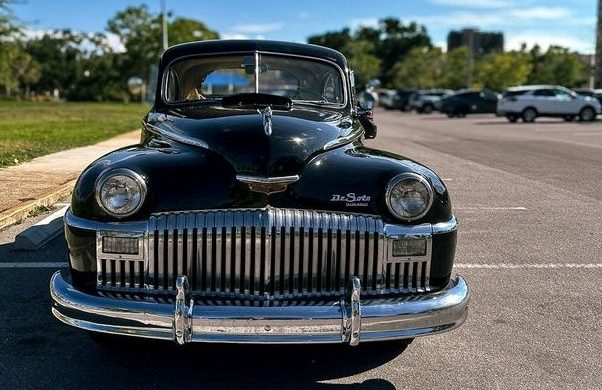
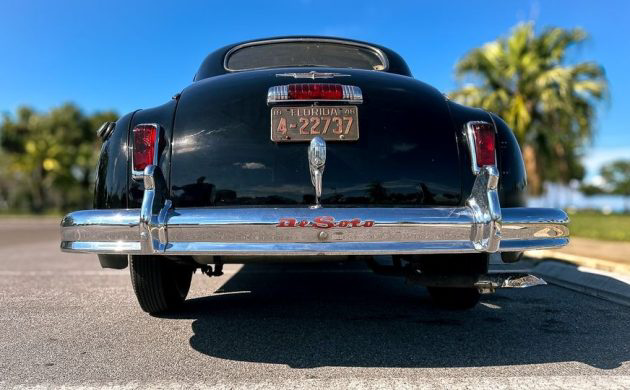
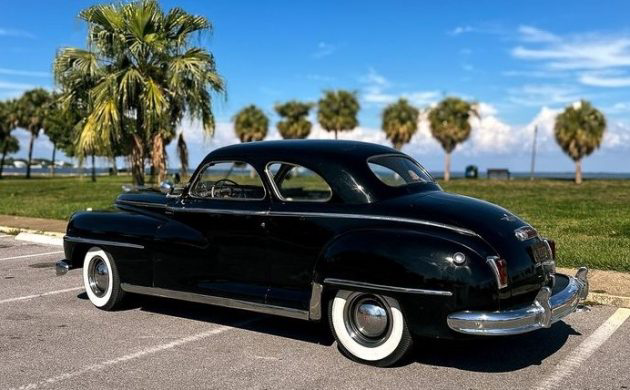
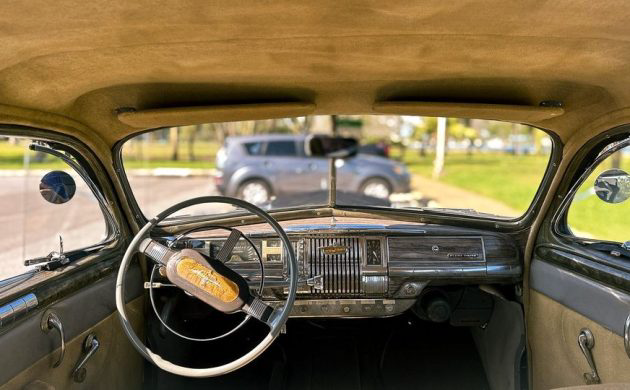
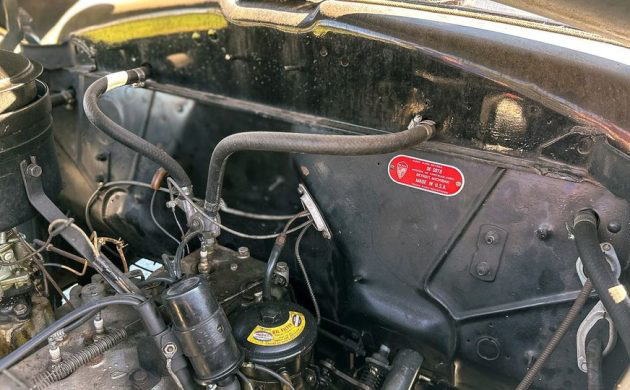
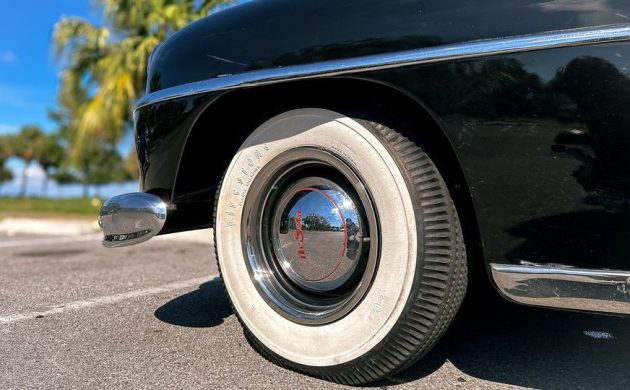


( crickets chirping) I usually gauge the amount of comments are directly related to the amount of interest. In this case, bupkus. Not only do I feel bad for the authors that spend hours researching these vehicles, and nobody cares. Well, I do, and a great writeup on DeSoto. This was “pre-Groucho”, as I think the 1st DeSoto he pitched was a ’52( with power steering) and DeSoto hadn’t quite gotten the glitz like after he began his sales schtick, and boy howdy, it worked. Sales almost doubled for DeSoto, even though they had a host of new options, it was Groucho that sold the cars. I think the fluid drive will be more confusing than an all out manual, but once mastered, be a great car for traveling. You want attention, you’ll get it with this.
This car was built well before my area of interest, 60’s and later, but I’ve always had a soft spot for DeSotos. I really like this one, the grille and the dashboard are just wunderbar. I truly hope someone will grab it and enjoy it, but it will be an older person, and then what will happen after they pass? Younger people just don’t like cars anymore, like we did.
I was thinking the same thing as HoA said above. Some cars the comments fly, others….. Not so much…… This is a beautiful DeSoto. Beautiful lines, and I personally would live a chance to drive any Chrysler product with fluid drive just for the experience. This looks like an absolutely great old car to buy and get into the hobby with. And I sure do hope it gets preserved.
My second ever car, back in 1956, was a 1941 Chrysler Windsor with Fluid Drive. It was a beater in fairly rough condition but as a 17 year old $35 was just about affordable. My first car, at $15, was a British 1939 Morris 8 convertible so the difference was amazing. As for the Fluid Drive, I didn’t know anything about it or how it worked so I just drove the car like any other, however, I seem to remember that using the clutch once on the move was unnecessary as I could just move the gear lever into whatever gear I needed without hearing any crunching sounds. Later I discovered that I could do the same with My 1957 Austin Westminster 105 if I removed the fuse for the overdrive! Great fun.
Looks like the one my uncle had when I was a boy.
I’m impressed by the hp they got from a straight 6, reminds me of Hudsons.
I had a 1948 Chrysler Windsor 2 door. Same styling. To engage the overdrive you had to get it up to speed and take your foot off of the gas momentarily and it would shift into overdrive. Those old cars kept you in shape. Without all of the creature features no power steering brakes windows or seats you got a workout.
Herewith a picture of a 1941 Chrysler Windsor, not mine, that had the Fluid Drive transmission. Great car.
What a beautiful Desoto. I’m afraid other comments are correct, that not too many are interested in this year car. I definitely like them. I have a 48 New Yorker I’m bringing back and that fluid drive does take some research to master. Fair price for one in driving condition like this one.
My aunt had a 51 coupe 2 tone green with 24,000 miles on it , she bot it new, and when she passed in the mid 70’s I should have bot it but never gave it a thought,it was basically like new, but where ever it went I don’t know cause we used to go to alot of car shows and never saw it , sooo if anybody knows of a 2 tone green 51 DeSoto let me know,,thanks
That is a good price if shape is as indicated. The dash on these is a work of art.
Here is my 1947 New Yorker business coupe. Very smooth, heavy car.
@Doremonger,the entire car is a work of art. People dressed very fashionable back then wide lapel double breast suits pinch point fedoras pleated cuffed slacks and cap toe or wing tip shoes. Women wore wide shoulder tapered dress suits no pants eh I mean with skirts below the knees a dress hats. What ever happened?
Doremonger, that’s a beautiful 47 New Yorker. I have a 48 New Yorker 3 pass business coupe as well. The straight 8 and fluid drive have been fun to work on for the last year. Mine is a survivor but needed it’s carb and fuel pump rebuilt, that and a good tune up.
Mine had gone though a total restoration and then sat in a car museum for 20+ years before I bought it. Replaced the leaking seals, cleaned and adjusted the brakes, and replaced the fluids and it is good to go. I am amazed by the radiators on these cars – the size of Hoover Dam.
Doremonger, Beautiful New Yorker. I had my Grandfather’s ’54 for a few years.
And I completely agree with you about this car. The dash is most definitely a work of art.
These were essentially warmed-over 1942 models. As such it was too bad they didn’t retain the hideaway headlights of the ’42s, (“airfoil lights” in DeSoto-speak) which really set those cars apart.
Not to get overly technical, but Fluid Drive was not a transmission — it was a fluid coupling that replaced the flywheel. The semi-automatic transmission (M6) was optional and paired with the fluid coupling. Since the semi-auto was optional, some cars had Fluid Drive but not the semi-auto. Those cars had a regular 3-speed manual with the fluid coupling which enabled clutchless driving if you stayed in the same gear but shifting between gears was manual.
As for the semi-auto, it had two ranges, high or low, selected manually, and you got one automatic upshift when you lifted off the gas in whatever range you were in. You could stay in high range for most driving but the tradeoff was very sluggish off the line acceleration.
You can also shift from the low range to the high range on the fly, which helps with the acceleration.
It took me forever learning how not to drive this fluid drive like a 3 speed manual. You rarely use the clutch other than shifting to reverse. Only two forward gears that has two speeds in each one. At a stop light you don’t have to use the clutch either. Early precursors to a fully automatic trans.
My father had a ’52 Dodge with the fluid drive. Yes, it took a bit of getting used to but I liked it because I hated using the clutch especially in heavy traffic.
Just to demonstrate how tastes can change, I never cared for these as the front was a massive toothy mouth, but as I’ve grown old(er) I really like the looks of this car. As someone pointed out, too bad they got rid of the hidden headlights of ’42.
I’ve blown up the picture and there is something on the rear window but I can’t make it out. Doesn’t look like a third brake light to me.
These cars, as most of this Era, had the brake light (not a third one but the only one) in the center of the trunk. The two lights on either side of the rear were the running lights and the brake light was on the trunk. The other two did not light up when you stepped on the brake.
I have a 1/18 scale model of a ,48 Chrysler convertible, would love one of a Desoto.
Love the imprint of “Desoto” on the rear bumper. That was back when they let you know what the car was. Today you have to know your emblems to figure out the make of the car. Took me months to figure out what a Polstar was. Even Cadillac doesn’t say Cadillac anymore, just the emblem and model (CT5 as an example)
Tiger66 gave a good explanation of how the Fluid Drive semi-automatic works. You can shift manually but it doesn’t really make much difference in acceleration. Beautiful car. I hope it gets a good home.
Barnfinds, thank you for the beautiful write up about my car. Greenhorn, like you, cars of this era were really not on my radar much. I’m 60 years old and I’m very much into German and Japanese cars of the ’80s and ’90s but when I saw this beauty, I fell in love. I’d always thought these would be costly to aquire because of all the chrome and majestic beauty. While other cars from my collection have sold within days at near asking prices, I knew this would take a bit longer to find the right new home. I posted the driving video on FB so all could see that she’s not just a looker but also runs very well.
Lovely car!
Post Script – I always find it annoying when one refers to an Imperial as a “Chrysler Imperial” as it seems redundant. I only added “Chrysler” after so many people asked me if a DeSoto was an Italian or other foreign nameplate!
Lovely car!
Doremonger, since your 47 New Yorker went through a total restoration, would you mind sending me some pics of your carb and specifically, the wire running from carb to relay terminal? I’ve had to put my 48 back together and did use wiring diagram, but would still help seeing on that has been done and is working. Thanks